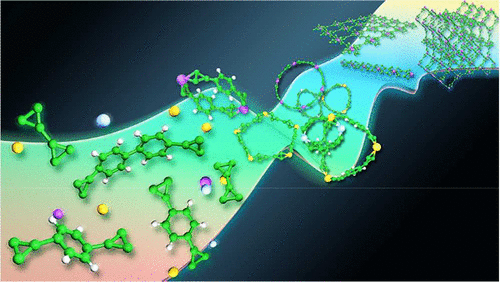当前位置:
X-MOL 学术
›
J. Am. Chem. Soc.
›
论文详情
Our official English website, www.x-mol.net, welcomes your feedback! (Note: you will need to create a separate account there.)
The Simplest MOF Units for Effective Photodriven Hydrogen Evolution Reaction
Journal of the American Chemical Society ( IF 15.0 ) Pub Date : 2018-06-29 , DOI: 10.1021/jacs.8b04599 Ting Liao 1 , Liangzhi Kou 1 , Aijun Du 1 , Yuantong Gu 1 , Ziqi Sun 1
Journal of the American Chemical Society ( IF 15.0 ) Pub Date : 2018-06-29 , DOI: 10.1021/jacs.8b04599 Ting Liao 1 , Liangzhi Kou 1 , Aijun Du 1 , Yuantong Gu 1 , Ziqi Sun 1
Affiliation

|
Metal-organic frameworks (MOFs) combining the merits of both organic and inorganic functional building structures are fundamentally important and can meet the requirement of vast scientific and technological applications. Intrigued from the fact that transition metals (TMs) are widely embedded in the carbon sp2 network or strongly interact with a bare graphene edge, the single transition metal atom may work as a linker to connect carbon chains to build nanoarchitectures. A new MOF building structure, [Metal-Carbon-(Benzene) i-Chain] n ring abbreviated as [M-CB iC] n (M = Ti, V, and Cr), with increasing carbon chain length i (= 0, 1, 2, ···), was proposed as carbon chains CB iC connected by a single transition metal atom M to form a ring structure with multiedges n (= 2-6), based on advanced computational methods. They are thermodynamically stable and chemically and physically versatile with ring shape, electronic structures, optical response, as well as hydrogen adsorption energy that vary by changing the length of the carbon chain, the edge number of rings, or the type of connecting metal atoms. The optical response to incoming light of [M-CB iC] n rings can be adjustable to cover the entire visible solar spectrum range and exhibit a red shift by either increasing the edge number n or filling the d bands in connecting transition metals. In combination with their ideal adsorption energy of hydrogen atoms, |Δ GH*|, the proposed [M-CB iC] n building structure is attractive for photocatalytic or photoelectrochemical hydrogen evolution applications when they are extended in space to build up 1D, 2D, and 3D MOF frameworks.
中文翻译:

用于有效光驱动氢析出反应的最简单的 MOF 单元
结合有机和无机功能建筑结构优点的金属有机框架(MOFs)具有根本的重要性,可以满足广泛的科学和技术应用的要求。由于过渡金属 (TM) 广泛嵌入碳 sp2 网络中或与裸露的石墨烯边缘强烈相互作用,因此单个过渡金属原子可以作为连接碳链以构建纳米结构的接头。一种新的 MOF 构建结构,[Metal-Carbon-(Benzene) i-Chain] n 环缩写为 [M-CB iC] n (M = Ti、V 和 Cr),随着碳链长度 i (= 0, 1, 2, ...),基于先进的计算方法,被提议为碳链 CB iC 由单个过渡金属原子 M 连接以形成具有多边 n (= 2-6) 的环结构。它们具有热力学稳定性和化学和物理多功能性,具有环形状、电子结构、光学响应以及氢吸附能,这些能量随碳链长度、环的边数或连接金属原子的类型而变化。[M-CB iC] n 环对入射光的光学响应可以调节,以覆盖整个可见太阳光谱范围,并通过增加边缘数 n 或填充连接过渡金属中的 d 带表现出红移。结合它们对氢原子的理想吸附能 |ΔGH*|,所提出的 [M-CB iC] n 构建结构在空间扩展以构建 1D、2D、和 3D MOF 框架。
更新日期:2018-06-29
中文翻译:

用于有效光驱动氢析出反应的最简单的 MOF 单元
结合有机和无机功能建筑结构优点的金属有机框架(MOFs)具有根本的重要性,可以满足广泛的科学和技术应用的要求。由于过渡金属 (TM) 广泛嵌入碳 sp2 网络中或与裸露的石墨烯边缘强烈相互作用,因此单个过渡金属原子可以作为连接碳链以构建纳米结构的接头。一种新的 MOF 构建结构,[Metal-Carbon-(Benzene) i-Chain] n 环缩写为 [M-CB iC] n (M = Ti、V 和 Cr),随着碳链长度 i (= 0, 1, 2, ...),基于先进的计算方法,被提议为碳链 CB iC 由单个过渡金属原子 M 连接以形成具有多边 n (= 2-6) 的环结构。它们具有热力学稳定性和化学和物理多功能性,具有环形状、电子结构、光学响应以及氢吸附能,这些能量随碳链长度、环的边数或连接金属原子的类型而变化。[M-CB iC] n 环对入射光的光学响应可以调节,以覆盖整个可见太阳光谱范围,并通过增加边缘数 n 或填充连接过渡金属中的 d 带表现出红移。结合它们对氢原子的理想吸附能 |ΔGH*|,所提出的 [M-CB iC] n 构建结构在空间扩展以构建 1D、2D、和 3D MOF 框架。



























 京公网安备 11010802027423号
京公网安备 11010802027423号